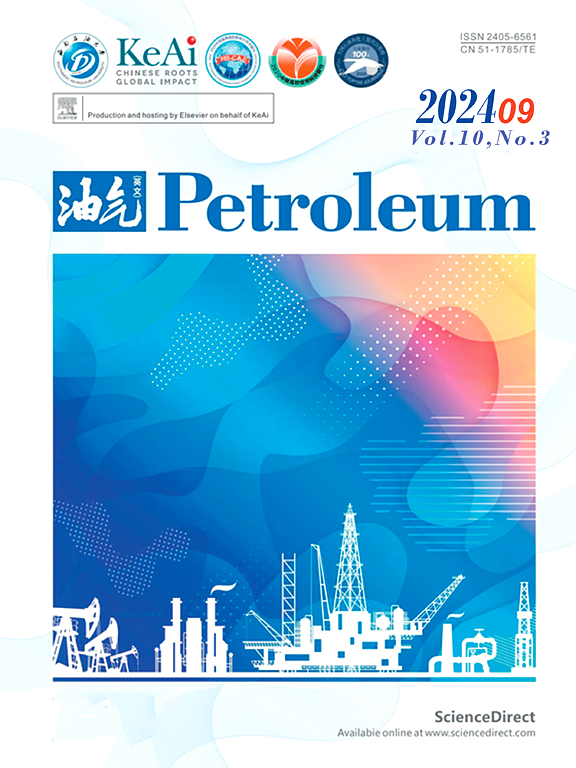Numerical simulation of seismicity potential resulting from the injection of CO2 into depleted reservoir in Wilbarger County field, Texas
IF 4.2
Q2 ENERGY & FUELS
引用次数: 0
Abstract
Fluid injection in fractured rocks presents significant challenges requiring the integration of various elements to account for reservoir property heterogeneities. To understand magnitude of potential seismic risks resulting from CO2 injection in naturally fractured sand reservoirs in the study location, we devised a simulation model which utilizes a coupled thermo-hydro-mechanical (THM) approach, encompassing different injection scenarios and reservoir injection systems. The model effectively captures the complex interplay between geological features and fault failure processes. Furthermore, we examined the mechanical response of the caprock under constant injection rates by analyzing the evolution of shear stress and its impact on permeability enhancement. Our findings reveal that the pressurization effect of fluid and stress alterations trigger significant fault rupture, leading to seismic events of varying magnitudes. The extent of seismic activity hinges on the reservoir's initial state, the properties of the overlying caprock, and the injected volume. Moreover, we discovered that deformations within the caprock layer are most pronounced near fault zones, gradually diminishing with distance from these zones. Notably, the degree of permeability modification in the caprock is linked to the magnitude of shear stress. Additionally, our research corroborated that higher injection rates markedly accelerate fault slip, albeit with minimal impact on the extent of permeability enhancement. However, we noted a non-linear relationship between seismic activity and fluid injection rates, suggesting that the magnitude of seismic consequences is contingent upon the temporal analysis of various parameters. These significant findings offer valuable insights into understanding the intricate processes associated with subsurface injection, which often manifest in phenomena such as fault ruptures and induced seismicity.
德克萨斯州Wilbarger县油田枯竭油藏注入二氧化碳引起的地震活动性潜力的数值模拟
裂缝性岩石的流体注入带来了巨大的挑战,需要综合各种因素来解释储层物性的非均质性。为了了解研究区域天然裂缝性砂岩储层中二氧化碳注入所带来的潜在地震风险程度,我们设计了一个模拟模型,该模型采用了热-水-机械(THM)耦合方法,涵盖了不同的注入场景和油藏注入系统。该模型有效地捕捉了地质特征与断层破坏过程之间复杂的相互作用。此外,通过分析剪切应力的演化及其对渗透率提高的影响,研究了恒定注入速率下盖层的力学响应。我们的研究结果表明,流体和应力变化的加压效应触发了显著的断层破裂,导致不同震级的地震事件。地震活动的程度取决于储层的初始状态、上覆盖层的性质和注入量。此外,我们发现盖层内部的变形在断裂带附近最为明显,随着距离断裂带的距离逐渐减小。值得注意的是,盖层渗透率的改变程度与剪切应力的大小有关。此外,我们的研究证实,较高的注入速率显著加速了断层滑动,尽管对渗透率提高的程度影响很小。然而,我们注意到地震活动与流体注入速率之间存在非线性关系,这表明地震后果的大小取决于各种参数的时间分析。这些重要的发现为理解与地下注入相关的复杂过程提供了有价值的见解,这些过程通常表现在断层破裂和诱发地震活动等现象中。
本文章由计算机程序翻译,如有差异,请以英文原文为准。
求助全文
约1分钟内获得全文
求助全文
来源期刊

Petroleum
Earth and Planetary Sciences-Geology
CiteScore
9.20
自引率
0.00%
发文量
76
审稿时长
124 days
期刊介绍:
Examples of appropriate topical areas that will be considered include the following: 1.comprehensive research on oil and gas reservoir (reservoir geology): -geological basis of oil and gas reservoirs -reservoir geochemistry -reservoir formation mechanism -reservoir identification methods and techniques 2.kinetics of oil and gas basins and analyses of potential oil and gas resources: -fine description factors of hydrocarbon accumulation -mechanism analysis on recovery and dynamic accumulation process -relationship between accumulation factors and the accumulation process -analysis of oil and gas potential resource 3.theories and methods for complex reservoir geophysical prospecting: -geophysical basis of deep geologic structures and background of hydrocarbon occurrence -geophysical prediction of deep and complex reservoirs -physical test analyses and numerical simulations of reservoir rocks -anisotropic medium seismic imaging theory and new technology for multiwave seismic exploration -o theories and methods for reservoir fluid geophysical identification and prediction 4.theories, methods, technology, and design for complex reservoir development: -reservoir percolation theory and application technology -field development theories and methods -theory and technology for enhancing recovery efficiency 5.working liquid for oil and gas wells and reservoir protection technology: -working chemicals and mechanics for oil and gas wells -reservoir protection technology 6.new techniques and technologies for oil and gas drilling and production: -under-balanced drilling/gas drilling -special-track well drilling -cementing and completion of oil and gas wells -engineering safety applications for oil and gas wells -new technology of fracture acidizing
 求助内容:
求助内容: 应助结果提醒方式:
应助结果提醒方式:


